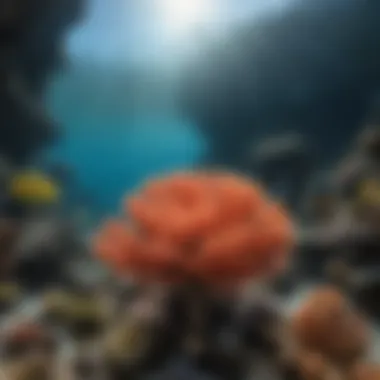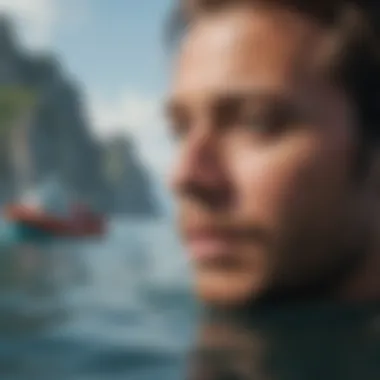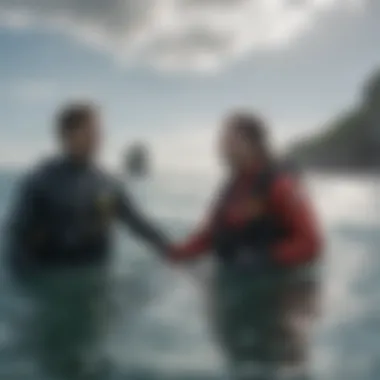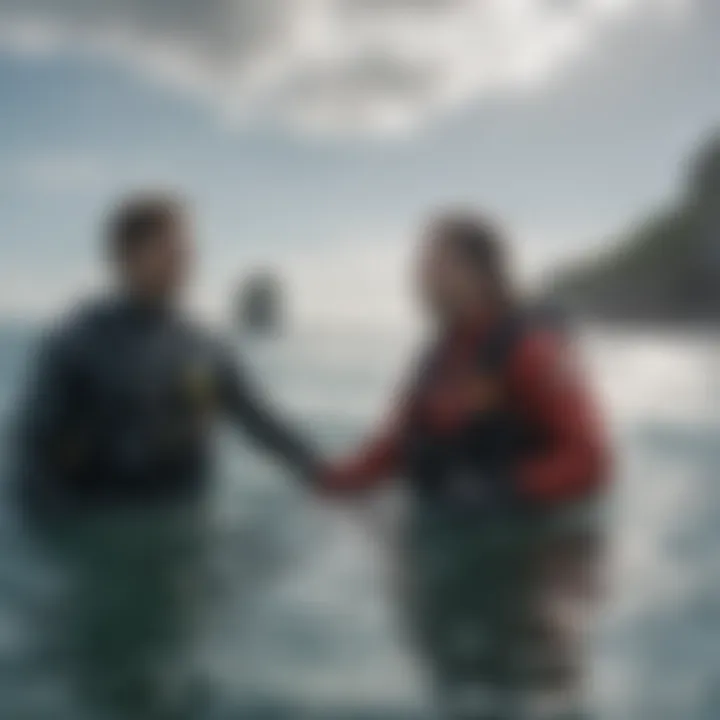Exploring the Depths: A Guide to Sea Facts and More


Intro
The sea captivates the imagination, doesn't it? Stretching far beyond the horizon, it cradles a world teeming with life and mystery. Yet, understanding this vast expanse requires more than just casual curiosity. This guide aims to peel back layers, revealing not just the ocean’s surface but its depths, where secrets and wonders abound. From the animated dance of marine creatures to the silent intricacies of underwater ecosystems, we’ll explore the astounding diversity and crucial roles of our oceans.
The sea is not only a physical entity; it also carries immense cultural significance across civilizations. Merchants of old navigated its waters, and communities thrived alongside its shores. But with human activities altering marine environments at a staggering rate, understanding the relationship between humanity and the sea becomes ever more vital. The goal here is to provide an enriched perspective on these interactions, laying groundwork for deeper knowledge, respect, and, ultimately, stewardship of our marine resources.
Techniques and Skills
Fundamental Techniques for Beginners
For those who are taking the first steps into the realm of water sports, mastering basic techniques is paramount. Regardless of whether you're setting out for sailing or snorkeling, having a firm grasp on foundational skills provides a safety net as you explore.
- Breathing Control: To fully enjoy the water, maintain steady breathing, especially when snorkeling. Take slow, deep breaths.
- Proper Body Positioning: For activities such as kayaking or paddleboarding, keeping your body balanced reduces fatigue and enhances control.
- Understanding Tides and Currents: Knowledge of local tides can significantly influence your safety when engaging in water sports. It’s essential to check conditions before heading out.
Advanced Skills for Experienced Athletes
For those with a desire to elevate their game, venturing into advanced techniques can profoundly change your experience. Understanding these more intricate skills can help you navigate complexities and challenges that arise in water sports.
- Advanced Navigation Skills: Familiarity with navigational tools and techniques can be a game changer, allowing you to chart your course even in less familiar waters.
- Rescue Techniques: Knowing how to assist someone in distress can not only save a life but also prepare you to face unexpected challenges during your adventures.
- Environmental Awareness: Be attuned to the conditions of the sea. Recognizing shifts in wildlife behavior can sometimes be indicators of changing weather or water conditions.
"The sea, once it casts its spell, holds one in its net of wonder forever." - Jacques Cousteau
In this guide, we will continue to dive deeper into the ocean’s essence, exploring safety measures, equipment recommendations, and the ecological threads binding us all to the blue depths. There’s so much more to uncover, so keep your feet paddling as we navigate these tides together.
Prelims to the Sea
The sea, a vast and captivating expanse of water, serves as a cradle for life and a critical component of our planet's ecosystem. It is not just an expanse of blue; it's a complex network of habitats and species that play pivotal roles in maintaining the balance of life on Earth. Understanding the sea goes beyond simple recognition; it is an exploration of the many ways it impacts our daily lives, economies, and cultures.
Defining the Sea
Defining the sea is more than just pinpointing its physical boundaries. It is a dynamic entity, encompassing oceans, seas, and even smaller bodies of saltwater, each contributing to the intricate web of marine life. Contrary to the common belief that the ocean is uniform, it is characterized by regions with distinct features, from the sunlit surface where life flourishes to the dark depths that remain largely unexplored. The major oceans include the Atlantic, Pacific, Indian, Southern, and Arctic Oceans, each housing unique environments and diverse species.
Additionally, terms like "marine" and "oceanic" are often bandied about, but they refer to different aspects of the sea. Marine generally refers to anything related to the sea, encompassing flora, fauna, and the environment itself, while oceanic is more about the physical attributes of the ocean body and its processes. Such distinctions matter in understanding how we interact with and influence these bodies of water.
Importance of the Sea in Human Life
The importance of the sea in human life cannot be overstated. From time immemorial, civilizations have flourished along coastlines and riverbanks, relying on the bounty of the sea for sustenance, trade, and transport.
The sea provides us with vital resources, including food, medicine, and energy sources. Here are a few ways the sea is central to human existence:
- Food Supply: Oceans are rich in biodiversity, supplying fish, crustaceans, and seaweed, which are staples in diets worldwide.
- Economic Impact: Coastal economies depend heavily on fishing, tourism, and maritime industries, generating significant income for many regions.
- Cultural Significance: The sea has inspired countless works of art, mythology, and literature, embedding itself into the cultural identities of many societies.
- Climate Regulation: Oceans play a crucial role in global climate control, absorbing carbon dioxide and regulating weather patterns.
"The sea is the most beautiful and expressive language. It is the echo of our emotional depths."
Recognizing the sea's contributions enhances our understanding, encouraging proactive measures for its conservation. Each aspect goes hand in hand with our responsibility to protect and cherish these precious resources for generations to come.
Physical Characteristics of the Sea
Understanding the physical characteristics of the sea is paramount for anyone wishing to appreciate the complexities of our oceans. These characteristics are the foundation upon which marine life thrives and the climate interacts with the water bodies. From depths that plunge to staggering numbers to the dance of currents on the surface, each detail entwines in a larger ecological web that is crucial for both the environment and human activity.
Depth and Dimensions
The sea is an enormous expanse, stretching across over 70% of the Earth's surface. Here, depth plays a pivotal role. The average depth of the ocean is about 12,080 feet (3,682 meters), with the Mariana Trench being the deepest known point, sinking to approximately 36,000 feet (10,900 meters). It’s important to note that these figures aren’t just numbers; they influence pressure, temperature, and light availability.
- Bathymetry reveals underwater topography which affects ocean circulation and marine habitats.
- Knowing depth changes can also aid in pollution dispersion calculations and understanding marine ecosystems.
- Each depth zone hosts distinct life forms, from the sunlit epipelagic zone to the dark abyssal plain. Many species adapt uniquely to their depth, showcasing extreme adaptations such as bioluminescence or unique nutrient sourcing methods that defy typical life forms.
Salinity and Temperature
Salinity and temperature are vital metrics in the study of oceans. Salinity, the concentration of salts in seawater, averages around 35 parts per thousand, but this varies considerably in different regions. For example, in river deltas, salinity may be lower due to the influx of freshwater. Conversely, evaporation in arid areas can increase salinity significantly.
- Temperature fluctuates from the hot surface waters in tropical regions to the freezing depths of polar seas.
- This temperature gradient is fundamental for ocean circulation; it drives thermohaline circulation, commonly referred to as the 'global conveyor belt,' which transports heat and nutrients around the globe.
- The delicate balance of salinity and temperature can greatly affect marine biodiversity, impacting where certain species can thrive.


"The ocean each year absorbs about a quarter of carbon dioxide emissions, playing a key role in climate regulation."
Waves and Currents
Waves and currents are like the ocean’s highways. They play a critical role in nutrient distribution and weather patterns across the globe. Waves arise from winds, with their height dependent on the speed and duration of wind. The energy from waves influences coastal erosion and shapes shorelines.
- Surface currents, driven by wind, affect coastal temperatures, often leading to localized climate variations.
- In contrast, deep currents, fueled by salinity and temperature gradients, are less visible but are equally important in maintaining global climate.
- The interaction between wave action and currents can create upwelling zones, rich in nutrients, supporting diverse marine life.
Understanding these fundamental physical attributes is not just about gathering information; it’s the first step in appreciating the vastness and importance of our oceans. Whether you’re a water sports enthusiast or a curious adventurer, these characteristics can significantly enhance your relationship with the sea.
Marine Biodiversity
Marine biodiversity encompasses the variety of life found in oceanic environments, from the smallest microscopic organisms to the largest creatures that roam its vast expanse. Understanding this diversity is not just an academic exercise; it has tangible implications for ecological stability, human health, and climate balance. The sea is home to an astonishing array of species—over 230,000 have been formally described, yet researchers estimate that there might be millions more waiting to be discovered. This staggering number makes the ocean a treasure trove of genetic resources and ecological functions.
Healthy marine biodiversity supports food chains, generates oxygen, and regulates climate. Each species, no matter how small, plays a role in its ecosystem. A loss in biodiversity can have cascading effects, disrupting food webs and deteriorating habitat quality. Preserving marine biodiversity is akin to securing a safety net for the ecosystems that sustain life on Earth.
"The loss of even one species can set off a domino effect, threatening entire ecosystems and, ultimately, human survival."
In a world increasingly shaped by climate change and human activity, the urgency to protect these vital resources has never been greater.
Species Diversity
The concept of species diversity in our oceans is more than a mere catalog of fish or whales. It refers to the variety of different species in a particular habitat, each one contributing uniquely to its surroundings. For instance, take a coral reef—their vibrance isn't solely in their colors, but in the multitude of life they support. These reefs are often referred to as the "rainforests of the sea" because of the immense biodiversity they harbor.
- Fish, like clownfish and surgeonfish, have adapted to thrive in and around coral reefs.
- Invertebrates, such as starfish and sea cucumbers, play crucial roles in nutrient recycling.
- Algae and other microorganisms serve as the base of the food web, creating an essential balance.
Some species even have relationships that can’t be classified neatly. Clownfish and anemones engage in a mutualistic relationship—whereboth species benefit. The fish gain protection, while the anemones get nutrients from the clownfish. Such complexity shows that every player matters in maintaining the balance of marine ecosystems.
Coral Reefs and Their Significance
Coral reefs’ significance extends beyond their ecological contributions—these structures are vital for the livelihood of many coastal communities. They act as barriers against storm surges, reducing coastal erosion. Without them, many coastal areas would be unprepared for the effects of climate change.
Moreover, coral reefs are a hotspot for biodiversity, hosting around 25% of all marine life. This makes them crucial in the fishing economy, where millions depend on healthy fish populations for sustenance. In addition, they are essential in tourism, attracting snorkelers and divers eager to witness their beauty firsthand. However, they are also incredibly sensitive to changes in water temperature and quality, leaving them vulnerable to climate change and pollution. To put it plainly, preserving coral reefs is not just about saving pretty fish; it directly affects human livelihoods and defends against climate threats.
Marine Habitats: Coastal, Open Ocean, and Deep Sea
Different marine habitats each offer unique ecosystems that vary in biodiversity and species adaptation. Understanding these habitats is crucial for conservation efforts.
- Coastal Habitats: Here, the interaction between land and water fosters rich biodiversity. These areas include estuaries, mangroves, and intertidal zones, housing numerous species that depend on the nutrient-rich waters. Coastal habitats act as nurseries for many fish, offering safe havens for their young.
- Open Ocean: Often viewed as a desolate space, the open ocean is teeming with life. Large marine animals, including dolphins and sharks, roam these vast areas, while many smaller, often unnoticed species form essential parts of the oceanic food web.
- Deep Sea: This habitat is perhaps the least understood, filled with unique adaptations. Creatures like the anglerfish and giant squid harness bioluminescence to survive in complete darkness, showcasing how life can thrive under extreme conditions.
Marine habitats are interconnected, and changes in one can significantly impact others. As such, protecting each of these habitats is vital for maintaining marine biodiversity and ensuring the health of our oceans.
Ecological Importance of the Sea
The sea serves as a keystone in the ecological fabric of our planet. It's more than just a vast expanse of water; it’s a complex system teeming with life and vital processes that sustain both marine and terrestrial ecosystems. The oceans cover about 71% of Earth's surface, influencing weather patterns, climate systems, and biodiversity. This section delves into the various ecological roles the sea plays, highlighting how it connects to climate regulation, carbon sequestration, and biodiversity.
Role in Climate Regulation
The oceans are integral in climate stabilization. They act as a massive heat sink, absorbing sunlight and redistributing thermal energy around the globe. For instance, warm ocean currents like the Gulf Stream transport heat from the equator to higher latitudes, effectively moderating temperatures. This, in turn, influences weather phenomena; without the oceans, many regions would experience extreme climates.
Furthermore, the sea facilitates the water cycle through evaporation, which helps maintain humidity levels and precipitation patterns. This cyclical action is crucial for sustaining agriculture and freshwater supplies in coastal areas and beyond. The interaction between the sea and atmosphere is delicate yet crucial – the health of our oceans directly impacts our climate.
Carbon Sequestration
One of the ocean's crucial roles is carbon sequestration, which is a fancy way to say it captures and stores carbon dioxide. The sea absorbs approximately a quarter of the CO2 emissions produced by human activities. Phytoplankton, the tiny plant-like organisms in the sea, play a fundamental role in this process. They photosynthesize, using sunlight to convert CO2 into organic matter, effectively reducing atmospheric carbon.
"Healthy oceans are vital for mitigating climate change. Without them, we face dire consequences."
When these organisms die, they sink to the ocean floor, taking stored carbon with them. This natural phenomenon not only aids in regulating climate but also influences marine chemistry and biodiversity. However, rising CO2 levels lead to ocean acidification, a process harmful to marine life, particularly shellfish and coral reefs. Therefore, safeguarding marine ecosystems is paramount for sustaining this natural carbon sink.
Biodiversity and Ecosystem Services


The oceans are a treasure trove of biodiversity, home to an estimated two million species, and many remain undiscovered. This variety is critical for maintaining the health of marine and overall ecosystems. Coral reefs, often referred to as the "rainforests of the sea," are a prime example of how marine life contributes to biodiversity. They provide habitat, protect coastlines from erosion, and support countless species.
Moreover, ecosystems such as mangroves and seagrasses offer invaluable services: they act as nurseries for fish, filter pollutants, and mitigate flood risks. Healthy oceans yield significant economic benefits. Fisheries provide livelihood to millions and are crucial food sources.
In short, from supporting diverse marine life to offering ecosystem services that benefit humans, the sea embodies a multifaceted ecological importance that requires our respect and protection. Understanding these interconnections emphasizes our responsibilities toward ocean conservation.
In summary, the sea is not just a body of water; it’s a critical component of the Earth's ecosystem. Recognizing its ecological importance encourages us to engage more meaningfully in conservation efforts, ensuring that future generations can enjoy and benefit from the wonders of our oceans.
Human Interaction with the Sea
Human beings have always had a profound connection with the sea. This relationship is multifaceted, affecting not just our economies and livelihoods but also our cultural identities and ecosystems. Evaluating our interaction with marine environments reveals a complex web of dependencies and consequences. Fishing practices, tourism, and pollution are key aspects where this interaction plays out, each carrying implications that resonate through social, economic, and environmental spheres.
Fishing Practices and Sustainable Management
Fishing is often seen as a way of life for many coastal communities. However, as populations grow and technology advances, overfishing has become a pressing concern. This strain on marine resources prompts the need for sustainable management practices.
In many regions, traditional fishing methods are yielding to industrial practices that can devastate fish populations. For instance, trawling can cause significant harm to seabeds and bycatch can lead to the waste of non-target species. Therefore, adopting sustainable practices is paramount. This includes:
- Implementing seasonal fishing bans to allow populations to recover.
- Utilizing selective fishing gear to reduce bycatch.
- Promoting aquaculture as a viable alternative.
Not only do these practices help preserve biodiversity, but they also secure livelihoods for future generations. Local fisherfolk, community organizations, and governments must work together to promote sustainability at all levels of the fishing industry.
Marine Tourism: Opportunities and Challenges
Marine tourism is booming, with people flocking to beaches, diving spots, and fishing tours. While this sector offers significant economic benefits, it also presents unique challenges.
Tourism can sometimes lead to habitat destruction. Coral reefs and coastal ecosystems are particularly vulnerable. Thus, responsible tourism initiatives are crucial. Here are several strategies to enhance positive impact:
- Eco-friendly practices: Tour operators can emphasize low-impact activities, like snorkeling instead of scuba diving, to minimize damage.
- Education: Informing tourists about local ecosystems helps foster respect and appreciation, promoting conservation efforts.
- Regulations: Enforcing limits on visitor numbers and development can help protect fragile areas.
Ultimately, balancing economic gain with ecological stewardship is the goal. Controlling the scale and style of tourism is vital for preserving the beauty that attracts visitors in the first place.
Pollution and Its Impact
Pollution is perhaps the most significant threat to our oceans today. From plastic waste that chokes marine life to chemicals that disrupt ecosystems, the consequences can be dire.
Marine pollution comes in various forms:
- Plastic waste: Millions of tons of plastic enter the oceans yearly, affecting wildlife and habitats. Animals often ingest plastic or become entangled.
- Chemical runoff: Pesticides and fertilizers washed into the sea can cause algal blooms, harming marine species and disrupting food chains.
- Oil spills: These devastating events not only kill marine life but have long-lasting effects on ecosystems.
To combat this, individuals and organizations are stepping up. Community beach clean-ups, stricter regulations on waste disposal, and public awareness campaigns all play a part. Overcoming pollution requires collective action; as the saying goes, "many hands make light work."
Conservation Efforts
Conservation efforts play a crucial role in ensuring the sustainability of marine environments. As the seas face escalating threats from pollution, climate change, and overfishing, these efforts become more important than ever. Things like habitat restoration, species protection, and sustainable fishing practices form the backbone of strategies aimed at preserving the delicate balance of ocean ecosystems.
International Agreements and Treaties
Numerous international agreements and treaties serve as frameworks aimed at preserving marine life and habitats. One of the key agreements is the United Nations Convention on the Law of the Sea (UNCLOS), which establishes guidelines for the sustainable use of ocean resources. Through agreements like these, nations come together to address shared challenges.
- Convention on Biological Diversity (CBD) aims to protect biodiversity and sustainable management across various ecosystems, including marine environments.
- The Ramsar Convention focuses specifically on wetland conservation and underscores the importance of these ecosystems for biodiversity and human livelihoods.
Such agreements represent a collective acknowledgment of the oceans' significance and the necessity for responsible management. While not all nations may strictly adhere to these treaties, they provide a platform for dialogue and cooperation on conservation issues.
Marine Protected Areas: Goals and Effectiveness
Marine Protected Areas (MPAs) serve as safe havens for many marine species, allowing ecosystems to recover and thrive without human intervention. The principal goal of these areas is to preserve biodiversity and critical habitats. MPAs can vary in protection levels, from fully protected zones to areas allowing sustainable use of resources.
- Biodiversity Conservation: They help maintain diverse populations of marine species.
- Ecosystem Resilience: MPAs enhance the ability of ecosystems to recover from disturbances, such as climate change.
However, establishing and enforcing MPAs can be tricky. Local communities may rely on the resources within these areas, creating potential conflicts. The effectiveness of MPAs often hinges on adequate support and compliance from local stakeholders, as well as consistent monitoring and scientific research.


"Oceans cover more than 70% of our planet. Protecting these vast resources ensures they continue to support life above and below the surface."
Community Involvement in Conservation
Community involvement is crucial for the success of conservation initiatives. Strategies that engage local populations yield a greater chance of efficacy because they incorporate traditional knowledge and practices that may have existed for generations.
- Education and Awareness: Communities that understand the value of their marine resources are more likely to take proactive steps in their conservation.
- Participatory Management: Involving local communities in decision-making processes fosters ownership and responsibility for conservation outcomes.
Grassroots movements and local NGOs often lead successful conservation campaigns, mobilizing resources and knowledge in ways that larger organizations may not achieve. Community-driven initiatives often lead to innovative solutions that reflect the unique needs of the region.
In summary, conservation efforts are imperative not just for the ocean's health, but for the world's future. Combining international agreements, protected areas, and community involvement creates a more comprehensive approach to safeguarding our seas.
Cultural Significance of the Sea
The entwinement of the sea with human culture is indelible and profound. For centuries, various societies have woven the sea into their existence, shaping customs, beliefs, and identities. It serves not only as a source of sustenance but as a canvas reflecting human creativity and resilience. Understanding the cultural significance of the sea can provide invaluable insights into our history, artistry, and even mythology.
Historical and Mythological Perspectives
Historically, the sea has played a pivotal role in the growth of civilizations. Ancient peoples, from the Phoenicians to the Vikings, ventured across vast oceans, forging trade routes that connected distant lands. These journeys often came with tales of maritime heroes and ferocious sea monsters, enriching folklore and shaping cultural identities. For example, in Greek mythology, Poseidon, the god of the sea, embodied the dual nature of the ocean—both nurturing and destructive.
"The sea is a vast storybook, where every wave can whisper of a hero's journey or a lost civilization."
In various cultures, the ocean is seen as a boundary, marking the divide between the known and the unknown. Many indigenous peoples have deep spiritual connections to the sea, viewing it as a source of life and a spirit in itself. Traditions and rituals around fishing, navigation, and even the conservation of marine life are infused with reverence, illustrating a sacred bond with the waters.
Art and Literature Influenced by the Sea
The allure of the sea has also significantly influenced artistic expression. Literature, from Moby Dick to The Old Man and the Sea, captures not just human struggle but also the profound relationship people have with the ocean. Poets and writers have drawn inspiration from the myriad moods of the sea, producing works that echo humanity’s battles and triumphs.
In visual art, the sea provides a vivid backdrop for reflection and emotion. Artists like J.M.W. Turner and Winslow Homer explored light, movement, and the sublime qualities of water, showing how the sea can evoke a rich tapestry of feelings—tranquility, chaos, beauty. It’s no accident that so many masterpieces depict the ocean, as it stands as an eternal muse.
Traditional Practices Related to Seafaring
Seafaring practices are deeply ingrained in many cultures across the globe. In places like the South Pacific, canoe building and navigation are not mere skills; they are traditions passed down through generations. The Polynesians, for example, mastered the art of wayfinding, using the stars, waves, and bird flights to traverse vast expanses of ocean.
Fishing techniques vary widely, reflecting the local ecosystem and community beliefs. From the potlatch ceremonies of the Pacific Northwest to the cooperative fishing efforts seen in Mediterranean fishing villages, these traditions show respect for the ocean and the life it sustains. They offer insights into communal responsibilities and the custodianship of marine resources, emphasizing the role of culture in fostering environmental stewardship.
In summary, the cultural significance of the sea encompasses a spectrum of human expression, belief, and respect. It serves as both a backdrop and a catalyst for cultural development, threading through history, art, and community practices. This multifaceted relationship underscores the importance of safeguarding our oceans, not just as a resource, but as the heart of a rich cultural legacy.
The Future of Our Oceans
The oceans are a vital lifeline for our planet, serving as a source of food, recreation, and climate regulation. As the marine environment faces numerous challenges—like climate change, pollution, and overfishing—it's imperative to delve into the future of our oceans. Addressing this topic allows us to recognize the significance of ongoing marine research, the contributions of citizens, and our ability to predict and improve the health of marine ecosystems.
Emerging Technologies in Marine Research
In today’s fast-paced world, technology plays a crucial role in understanding and conserving marine environments. For instance, satellite monitoring has evolved to provide real-time data on ocean temperatures and conditions. A recent advancement is the use of autonomous underwater vehicles (AUVs), which are equipped with sophisticated sensors. These AUVs can explore the depths of the ocean without putting human lives at risk. They collect vital information about underwater ecosystems, which can help scientists map biodiversity and track changes over time.
Additionally, genetic barcoding is changing the way we identify species. By analyzing DNA from water samples, researchers can uncover the presence of species that might be invisible to the naked eye. This helps in assessing biodiversity and allows for more effective conservation strategies.
By leveraging such technologies, we can address challenges faced by marine ecosystems. Awareness and proper data collection can drive conservation efforts, lead to better policy-making, and ultimately secure a brighter future for our oceans.
The Role of Citizens in Ocean Conservation
Citizens have a powerful role to play in the health of our oceans. Grassroots movements and local initiatives can lead to significant environmental change. Community-led beach clean-ups or local campaigns to reduce plastic use are tangible examples of how individuals can make a difference. Engaging people in these activities fosters a deeper connection to the sea and raises awareness about environmental challenges.
Social media has also become a platform for spreading awareness. Users can share stories about marine life, promote sustainable practices, and encourage others to join conservation efforts. The rapid sharing of information has made it easier to rally support for ocean protection policies.
Moreover, citizen science initiatives allow the public to contribute to data collection. For instance, projects like iNaturalist enable individuals to document marine species. When more people are involved in scientific endeavors, the collective knowledge base expands, informing conservation strategies and policies.
Forecasting the Health of Marine Ecosystems
Monitoring the health of marine ecosystems relies heavily on data analysis and forecasting models. Researchers use various methods to gather data, including underwater sensors and remote sensing technologies. By examining factors such as water quality, temperature variations, and species populations, scientists can predict ecosystem responses to environmental stressors.
One practical approach is the development of early-warning systems. These systems can alert authorities about harmful algal blooms or shifts in fish populations, allowing for timely interventions. A proactive stance can mitigate potential problems before they escalate.
Furthermore, establishing marine protected areas (MPAs) is essential for safeguarding species and habitats. Continuous research and monitoring within these areas can help evaluate their effectiveness, offering insights for future management.
In summary, the work we do today—through technology, community engagement, and predictive analysis—sets the stage for the future of our oceans. Understanding these elements not only benefits marine life but also enriches our connection to the sea, ensuring that future generations can enjoy and rely on these invaluable resources.















